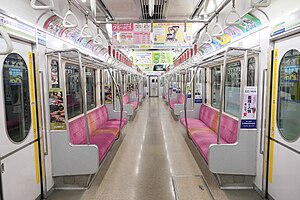You can help expand this article with text translated from the corresponding article in Japanese. (November 2022) Click for important translation instructions.
|
| Sendai Subway 1000N series | |
|---|---|
 A Sendai Subway 1000N series train, October 2008 A Sendai Subway 1000N series train, October 2008 | |
 Interior Interior | |
| In service | 1987–present |
| Manufacturer | Kawasaki |
| Constructed | 1985–1996 |
| Refurbished | 2003–2013 |
| Number built | 84 vehicles (21 sets) |
| Formation | 4 cars per trainset |
| Capacity | 144 passengers per car (58 seating, 54 post-refurbishment) |
| Operators | Sendai City Transportation Bureau |
| Lines served | Sendai Subway Namboku Line |
| Specifications | |
| Car length |
|
| Width | 2,890 mm (9 ft 6 in) |
| Height | 4,040 mm (13 ft 3 in) |
| Doors | 4 pairs per side |
| Maximum speed | 75 km/h (47 mph) |
| Weight | 128.0 t (126.0 long tons; 141.1 short tons) |
| Traction system | |
| Traction motors |
|
| Power output | 160 kW (215 hp) per motor |
| Transmission | Westinghouse-Natal drive; gear ratio: 5.73 : 1 (86 / 15) |
| Acceleration |
|
| Deceleration |
|
| Electric system(s) | 1,500 V DC (overhead catenary) |
| Current collector(s) | Pantograph |
| Bogies | SS-005, SS-105 |
| Braking system(s) | Electromagnetic braking |
| Safety system(s) | ATC/ATO (Fuzzy logic) |
| Track gauge | 1,067 mm (3 ft 6 in) |
The Sendai Subway 1000N series (仙台市交通局1000N系電車) is a rapid transit electric multiple unit (EMU) train type operated on the Sendai Subway Namboku Line in Sendai, Japan.
The 1000 series was the world's first train type to use fuzzy logic to control its speed, and this system developed by Hitachi accounts for the relative smoothness of the starts and stops when compared to other trains, and is 10% more energy efficient than human-controlled acceleration. It was the recipient of the 28th Laurel Prize award presented by the Japan Railfan Club.
Formation
Sets are formed as follows, with car 1 at the Tomizawa end.
| Car No. | 1 | 2 | 3 | 4 |
|---|---|---|---|---|
| Designation | Tc1 | M1 | M2 | Tc2 |
| Numbering | 1100 | 1200 | 1300 | 1600 |
History
First entering service in 1987, the fleet of 21 sets was constructed between 1985 and 1996.
Refurbishment
From 2003 until 2013, the 1000 series trains underwent mid-life refurbishment to extend their lifespan. Refurbished sets are renamed 1000N series, with the first such set returning to service in March 2004.
The refurbished trains include the following features.
- LED destination indicators at the train ends
- Space for wheelchairs
- Air-conditioning
- LED destination indicators inside trains
Replacement
The 1000N series sets are scheduled to be replaced with new 3000 series trains from 2024.
See also
References
- Andrew Pollack (2 April 1989). "Fuzzy Computer Theory: How to Mimic the Mind?". The New York Times. Retrieved 11 March 2011.
- Philip Elmer-DeWitt (25 September 1989). "Time For Some Fuzzy Thinking". Time. Archived from the original on 22 October 2010. Retrieved 11 March 2011.
- 私鉄車両編成表2021 [Private Railway Vehicle Organization Table 2021] (in Japanese). Japan: Kotsu Shimbunsha. 2021. p. 12. ISBN 9784330032214.
- 仙台市地下鉄南北線、新型車両は無塗装のアルミ合金製になる? - 鉄道ニュース週報(208) [Will the new trains on the Sendai Subway Namboku Line be made of unpainted aluminium?]. Mynavi News (in Japanese). 18 January 2020. Retrieved 29 October 2023.
- ^ 全国の地下鉄 仙台市交通局(仙台市営地下绣) [Subways Nationwide: Sendai Municipal Subway]. Japan Railfan Magazine (in Japanese). Vol. 48, no. 562. Japan: Koyusha Co., Ltd. February 2008. pp. 12–13.
- ^ 仙台市地下鉄南北線 新型車両3000系を公開、走行試験へ - 写真73枚 [Sendai Municipal Subway Namboku Line's new 3000 series shown off - 73 photos]. Mynavi News (in Japanese). 27 October 2023. Retrieved 29 October 2023.
External links
| Sendai Subway trainsets | |
|---|---|
| ■ Namboku Line | |
| ■ Tōzai Line | |